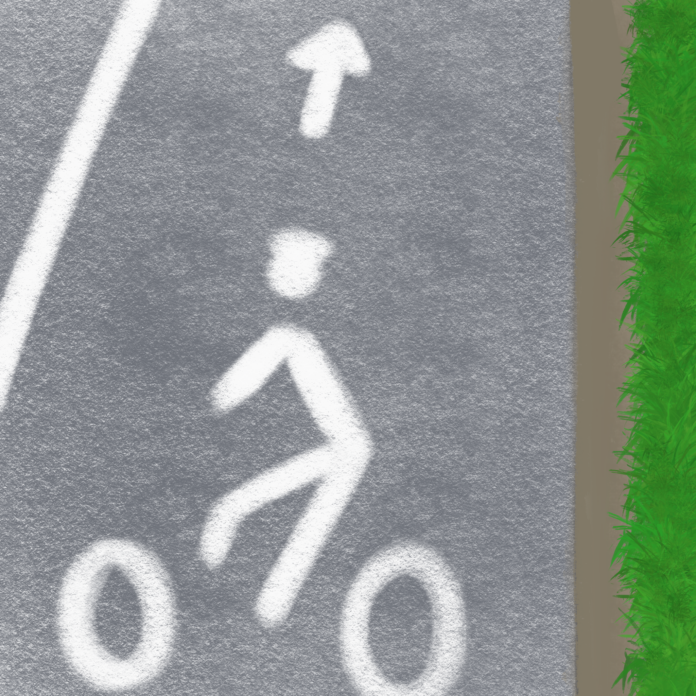Damien Kanner-Bitetti ’25 is an English major and American studies minor from Arlington, VA. In addition to the Flat Hat, he is a member of Club B Soccer, Jewish Voice for Peace, a librarian for the Meridian Coffeehouse and a DJ for WCWM. Email him at dskannerbitett@wm.edu.
The views expressed in this article are the author’s own.
“I’ll beat the brakes off you!” shouted the man driving the gray Subaru. Seconds before, he had gone straight through the stop sign at the corner of South Boundary and Francis Street, causing me to slam on my bike’s brakes and skid to a stop in front of his car. That he had come within feet of hitting me didn’t matter: He was furious that I had dared to shout at him for his reckless driving.
I’m leading with this anecdote (from just a few weeks ago) not because it’s emblematic of my experiences biking in Williamsburg, but because it was so atypical. For the most part, my daily bike rides to campus are one of the highlights of my day. They provide me with time to reflect before class, help me to appreciate the town’s beautiful scenery and architecture, and most importantly, allow me to avoid a long walk. However, there are some negative aspects of this biking experience, which not only dampen my enjoyment of it, but also place me and my fellow cyclists in danger.
The primary downside of biking around campus is the local bike lanes, which may be surprising: After all, Williamsburg has relatively decent bike infrastructure, sporting a Bronze rating from the American League of Cyclists. However, these lanes are largely unprotected, meaning that cars are a constant threat. Additionally, on many streets, especially Richmond Road, the lanes double as parking spots, meaning that they are frequently filled with parked cars — often illegally. In other areas around campus, bike lanes are often blocked by school maintenance vehicles and tour buses, or by cars edging out into the street (especially at the blind corner on James Blair Hall). All of this means that bicyclists are forced to move in and out of the road, which is extremely dangerous in and of itself, eliciting a consistent complaint from drivers.
The other major issue is the attitude which I invoked at the beginning of this piece: a lack of respect for biking. While my own anecdote is quite negative, I believe that it’s representative of a larger problem. Friends who bike tell me they’ve been honked at, cut off and in one case, even been run off the road. To be clear, the vast majority of drivers here are courteous, respectful and safe; I can’t count the number of times I’ve been waved on by a friendly face. However, those drivers who are hostile to cyclists are a very real danger and one that must be addressed.
There are relatively simple fixes for many of these issues. For example, if the school clarified its parking rules for maintenance vans, or if the city enforced parking restrictions more strictly, we would see many fewer blocked bike lanes. Other issues would require infrastructural investment, including the implementation of different parking rules and protected bike lanes. Still other issues, including anti-bike sentiment from drivers and bad biking practices from cyclists, require strengthened education, which organizations such as the College of William and Mary’s Bike Alliance and the town’s many bike clubs seek to provide.
For these positive changes to happen, however, those of us who bike will need to take accountability. It isn’t fair to ask for widespread reforms to the laws of the road while refusing to adhere to them. Biking on sidewalks or the wrong way in bike lanes is not only antisocial, but it is actually more dangerous than biking on the road, according to the Bike Alliance. Similarly, speeding through Sadler Terrace is unlikely to win bikers any friends on campus. However, I believe that these issues can be improved either through better infrastructure (in the case of the first two) or through education (in the case of the latter).
Biking is a relatively safe, convenient method of transportation on and around campus; it is one I intend to continue utilizing, and one which is growing in popularity as more students adopt it as a means of getting to class. However, that does not mean it is perfect; as demonstrated above, biking around campus has significant drawbacks, but they are very much solvable. I hope that those with the ability to do so — student leaders, school administration and the city of Williamsburg — will recognize the area’s potential to transform from an above-average biking community into a spectacular one.

